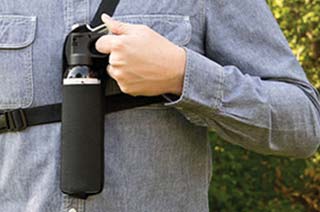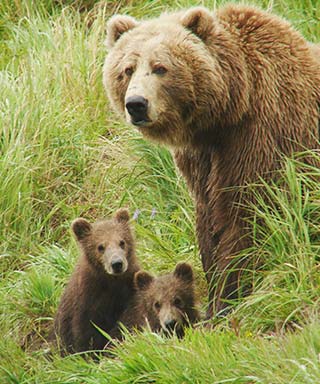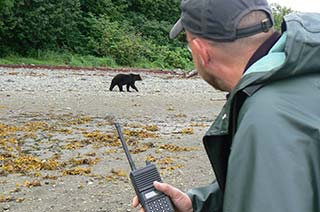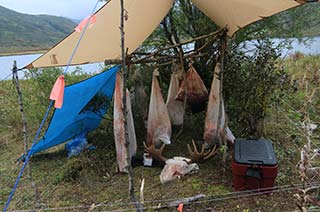Bear Safety for Hunters
Bears live almost everywhere in Alaska. While hunting, you may engage in activities such as moving stealthily, blending in with your surroundings, and handling, transporting and storing meat that will increase your risk for a bear encounter. The risk always exists, but you can help minimize some of it through wise decision-making.
Learn About Bear Behavior

You can help ensure your safety around bears by understanding their behaviors and the motivation behind those behaviors. Understanding bear behavior can help you react better if you encounter a bear. It's important to understand that your response when encountering a defensive bear or a non-defensive bear will be different. Your behavior influences the outcome of bear encounters.
Staying Safe in Bear Country, a video about bear behavior and how to respond to different types of encounters can help you feel better-prepared. Copies are available on loan from ADF&G area offices, or you may search online to order copies. (Also available to watch online at: youtu.be/s-zkGuh42l4)
Bear Encounters
If a bear hears or sees you coming in its direction, the bear will almost always move away from you. You may never see or hear that bear.
If you see a bear that DOES NOT notice you:
- Stay calm — Quietly leave the area from the same direction you arrived. Have your deterrent ready and keep your eyes on the bear.
- Do not approach — Never approach a bear, unless you are hunting a bear,
If a bear DOES notice you:

- Ready your deterrent — Hunters are likely to be carrying a firearm or bow. Consider carrying a second deterrent such as bear spray and have it accessible.
- Stay calm — Face the bear, stand your ground, and talk to it calmly. Your voice helps the bear identify you as human.
- Look big — Slowly raise your arms overhead so you appear larger. If your hunting partner is close by, stand side-by-side; this is another way to make yourselves look larger.
- Don't run — Running may elicit a chase response.
- Watch the bear — If the bear approaches, try to determine whether it is acting defensively or non-defensively. You should continue to stand your ground, but in an encounter, your response will be different depending on the behavior of the bear.
Encountering a defensive bear

A bear that you surprise or crowd, especially one with cubs or on a carcass, may feel threatened. The bear may be agitated, and may huff, stomp, make a popping sound with its teeth, salivate or lay its ears back against its head and charge. Your goal in a defensive encounter is to calm the bear — and yourself — and let the bear know you are not a threat.
- If you have time to respond, stand your ground, ready your deterrent, group up, talk to the bear in a calm voice and watch the bear. Do not run.
- If the bear is stationary, move away slowly while keeping your eyes on the bear.
- If the bear starts to move toward you or charges, stop and stand your ground.
- Let the bear know you are not a threat. Behaving calmly, moving slowly, and speaking in a low calm voice will help de-escalate the situation.
- If the bear continues to approach, use your deterrent when the bear is within range.
- Cubs and kill sites — Do not stand your ground at an occupied kill site or between a sow and her cubs. Instead, back away and leave the area immediately.
How to react in a defensive bear attack
An attack means that a bear has made physical contact with you. Understand that defensive bear attacks can occur so quickly that there is little time to respond. A majority of bear attacks are considered defensive. Although black and brown bears may react defensively, black bears rarely attack defensively. When they do, it often involves mother black bears defending their cubs. Most defensive attacks are from brown bears.
- If a defensive bear makes contact with you and knocks you to the ground, lie face down and clasp your hands behind your neck. Protect your neck, stomach and face. Spread your legs and elbows for stability so the bear cannot roll you over. Leave your backpack on for protection. Your goal is to have the bear no longer perceive you as a threat.
- Do not struggle or make any noise until you are certain the bear has left. This may seem like an eternity, but you cannot risk being re-attacked. Even if it is departing, the bear could look back at you to see if the perceived danger is still active.
- If the attack is prolonged and the bear starts feeding on you, it may no longer be considered defensive but may have turned into a predatory attack. In this case, fight back.
Encountering a non-defensive bear

Bears that are not feeling threatened may approach you for a variety of reasons. You may be on the bear's travel route, it may be curious, testing dominance, food-conditioned, habituated, or potentially predatory. Your goal in a non-defensive encounter is to let the bear know you are human, and that you will become more assertive as the bear persists.
- Your initial response to all bear encounters should be the same: Stand your ground, ready your deterrent, group up and watch the bear. Stay calm and talk to the bear in a firm voice.
- Do not play dead! If you panic, run or play dead with a non-defensive bear, you risk the encounter turning into a predatory attack.
- If you're on the bear's route, you may be blocking it. If this is the case, try to move out of its way while keeping an eye on the bear.
- If the bear persistently approaches, follows you and stays focused on you; it's time to assert your dominance and become aggressive. Stand your ground and don't retreat; shout, make yourself appear large, let the bear know you will fight, use any non-lethal deterrent such as bear spray, or throw rocks or sticks. Drive the bear off.
- There isn't any hard and fast rule regarding when to shoot a persistent and aggressive bear, it's a personal decision. If you do use a firearm, shoot at close range and aim to kill the bear.
How to react in a predatory bear attack
- If a bear deliberately approaches and contacts you in a situation where the behavior does not appear defensive, aggressively fight off the bear with any means available.
- Fighting the bear off is also warranted when a prolonged defensive attack becomes predatory and the bear begins feeding on you.
- Fight any bear that breaks into an occupied tent or building.
- Concentrate on the bear's face or muzzle with any potential weapon you have.
Remove Game Meat Immediately
Far more bear conflicts arise once you have downed a big game animal. Remember, in most cases, you will be packing out your animal in multiple trips which will increase the risk of encountering a bear.
- Field dress — Promptly field dress a game animal after the kill. If possible, avoid opening the gut cavity until after you have salvaged all other edible meat. Removing the hide first and avoiding opening the gut cavity will help limit odors.
- Be alert — Bears may be drawn to the kill site. Move the meat away from brushy areas as soon as you can. Try to pack all the meat out in one load. If this is not feasible, place the remaining meat in game bags and hang from a tree, or cache them in an open area at least 100 yards from the kill site.
- Leave the gut pile and excess bones or carcass for bears — Bears usually go for the entrails first. If you make multiple trips to retrieve game, move edible meat and salvaged portions away from the gut pile, to an area with good visibility.
- Mark the area — Use flagging tape to mark the entrails and the meat cache and likely approaches to it. When you come back for your second load of meat, you will know where your attention needs to be directed. Flagging also gets the attention of other hunters who happen onto the kill site. Approach flagged areas cautiously and be on the lookout for bears. Use flagging tape sparingly elsewhere on your hunt so as not to confuse the issue. Remove flagging tape on your last trip out.
- Make noise — When you are packing out game meat and have finished hunting for the day, make lots of noise to announce your presence to any bear in the area.
- Avoid leaving a blood trail back to your camp — Pack, do not drag, all the legally required salvaged meat and parts to the area where you will hang and store your meat.
- If you come back to your cache and a bear has claimed your meat — Do not try to drive the bear away. The meat is likely soiled and trying to scare off a feeding bear may provoke an attack. Alaska State Regulations prohibit killing a bear to retrieve hunter-killed game (see Defense of Life or Property [DLP] in the regulations).
- Remember your bag limit — If a bear takes your game meat, you are not entitled to take another animal to replace the one you "lost." Bag limits apply even if a bear takes your game meat.
Tips When Bringing Game Meat into Camp
- Cache your meat — Keep your meat out of reach of bears or cache the meat away from your camp with a clear line of sight between the camp and cache.
- Protect your camp — Portable electric fences are an inexpensive method of protecting your meat. Similarly, you can also use detection devices ranging from pots-on-a-string, to commercial motion detectors, or tripwire-electronic alarm systems. Many hunter-pilots use electric fences around their airplanes.
- Treat clothes soaked with blood or guts the same as any other attractant — Do not put them in your tent or wear them to bed. Leave soiled clothes with the meat cache.
- Deter bears in camp — If a bear comes towards your camp, make loud noises, yell at the bear, and bang pots and pans together to try driving the bear off. Assertively defend your camp. Stand in a group if possible and maintain your position. Your goal is to have the bear leave your camp.

